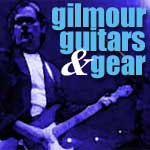


Gilmour, Guitars & Gear
David Gilmour's Blues Influence

In this column, I'll be examining Pink Floyd guitarist David Gilmour's gear and playing techniques from a musician's point of view. Please feel free to e-mail me with questions and ideas for future articles if you feel you have an idea that readers of Spare Bricks might find of interest. Past articles are now posted here.
When the "Blue Floyd" topic was first raised, members of the writing staff immediately debated the validity of this theme. Some felt that Pink Floyd's music was definitely influenced by the blues, while others completely disagreed, saying that there was no link to the blues in just about anything Pink Floyd had recorded. During the debate, staff writer Bob Cooney asked a friend with a musical background to describe the blues. The response was "The bending, or flattening, of the notes to elongate the sound allowing musicians to put more feeling and emotion into the music."
While Bob and others debated their own interpretations of this quote as it related to Pink Floyd as a band, I thought it would be interesting to write about my take on this statement. I've been a rock-oriented guitar player for over 30 years. Based on my experience, I have to agree that this statement definitely applies to Gilmour's guitar playing from two perspectives: phrasing and note choice.
Phrasing
I came to the revelation several years ago that guitar playing is not about what you play, but how you play it. Blues based guitar playing is based on characteristics such as the bending of notes and left hand finger vibrato.
The elements of guitar playing differ according to various styles of music. If you're playing flamenco guitar or jazz guitar, there are very few instances where a note is bent. In the case of classical guitar, most--if not all--of the notes are picked with the fingers of the right hand. Classical guitarists use nylon string acoustic guitars exclusively. Players study their right hand technique, the perfect balance between fingernail and skin, for years to achieve the perfectly picked note. For the left hand, classical and jazz guitar finger vibrato is achieved by moving the finger from side to side along the length of the string, similar to that of a violinist or any other classical stringed instrument.

In contrast, almost all of Gilmour's playing is derived from blues-based guitar players. Every player from B.B. King to Jimi Hendrix is an influence. In blues playing, the emphasis is on a vibrato that rocks the string down then up, perpendicular to the strings. The "feel" comes from the speed and intensity of the vibrato. (At the time I came to this realization, vibrato was the most important element missing in my own playing.) As for note bending, a skilled blues-based player, such as Gilmour, instinctively knows how long to hold a bent note, when to raise it, when to lower it, when to add vibrato, and how much vibrato to add.
And what is phrasing? It's perhaps best described as a pattern of notes that fall in the right place at the right time. The best analogy would be a player's ability to make the guitar "speak." In my opinion, no one does this better than Gilmour.
Note choice
You can take the notes of an augmented or diminished scale or arpeggio and play it with a sense of blues timing, bending and vibrato, but it will never sound like the blues. The notes are simply too far outside the pentatonic blues based scale.
And what is a pentatonic scale? It's a five-tone scale. The term is derived from the Greek roots "penta," ("five"--like the five-sided Pentagon building we Americans are familiar with), and "tonic" (which simply means "tone"). The nucleus of a chord is the first, third and fifth tones of a scale. So as an example, an A minor scale would be A, B, C, D, E, F, G and back to A. The pentatonic scale uses the first, third and fifth degree, plus the fourth and the seventh. Thus, the A minor pentatonic scale is A, C, D, E, G, and back to A. Simply put, a pentatonic scale uses the notes that are most in common with a chord form. That makes these notes incredibly melodic. Every note sounds right and this is the reason why.
 |
In both of the preceding examples, you can see how each pattern features two notes per string. Example 1, is an A minor pentatonic scale. This is the most used scale form in all styles of blues and blues influenced rock music. Example 2, the diminished arpeggio, is one of the more exotic scales to play on a guitar fretboard and is only used by rock guitarists looking for a change of pace from standard scales that are normally played.
In the end, I think it's safe to say that while some of the blues is incorporated into Pink Floyd's music, the blues is unquestionably the foundation of David Gilmour's guitar style.
